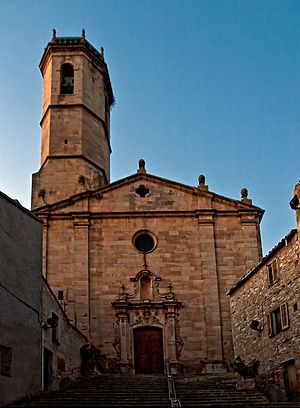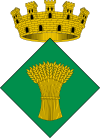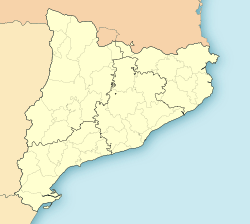Granyena de Segarra facts for kids
Quick facts for kids
Granyena de Segarra
|
||
|---|---|---|
|
Municipality
|
||

St. Mary's church, Granyena
|
||
|
||
| Country | ||
| Community | ||
| Province | ||
| Comarca | Segarra | |
| Area | ||
| • Total | 16.3 km2 (6.3 sq mi) | |
| Population
(2018)
|
||
| • Total | 147 | |
| • Density | 9.02/km2 (23.36/sq mi) | |
Granyena de Segarra is a small and charming village located in the province of Lleida, within the Catalonia region of Spain. Its name, Granyena, comes from the Latin word granaria, which means "granary" or "place for grain". This tells us that farming has been important here for a very long time. The village is part of the Segarra area, known for its beautiful landscapes and rich history. With a small population, Granyena de Segarra offers a peaceful glimpse into traditional Spanish life, surrounded by nature.
Contents
Discover Granyena de Segarra
Granyena de Segarra is a municipality, which means it's a local area with its own government. It's located in the central part of Catalonia. The village sits on a small hill, giving it nice views of the surrounding countryside.
Where is Granyena Located?
Granyena de Segarra is in the western part of Catalonia. It is part of the Segarra comarca, which is like a county or district. The village is about 70 kilometers (43 miles) from the city of Lleida. It's also not too far from other interesting towns in the region.
The area around Granyena de Segarra is mostly made up of fields. People grow crops like wheat, barley, and olive trees here. The landscape is gently rolling, with small hills and valleys. This makes it a great place for farming.
A Look at Granyena's History
Granyena de Segarra has a long and interesting past. The village likely grew up around a castle. This castle was built a very long time ago, possibly in the 11th century. It was part of a line of defenses that protected the Christian lands from invaders.
Over the centuries, the village changed hands many times. Different noble families owned the castle and the land. Life in Granyena was mostly about farming. People worked hard to grow food and raise animals. The village church, St. Mary's, has also been an important part of community life for hundreds of years.
Life in the Village Today
Granyena de Segarra is a very small village. In 2018, only about 147 people lived there. This means everyone probably knows each other! The community is close-knit and friendly. Many people still work in agriculture, continuing the traditions of their ancestors.
Even though it's small, the village has a local government. The mayor helps manage the village and make decisions for the community. Life here is quiet and peaceful, away from the busy cities. It's a place where you can experience traditional Catalan village life.
What to See and Do in Granyena
If you visit Granyena de Segarra, there are a few interesting spots to check out.
The Church of Saint Mary
The most important building in the village is the
Church of Saint Mary (Església de Santa Maria). This church has been rebuilt and changed over many years. It has parts that show different styles of architecture. The church is a central part of the village and its history. It's a beautiful old building to explore.
The Castle of Granyena
While not much of the original castle remains, you can still see some parts of it. The castle was once a strong fortress. It stood on the highest point of the village. Today, you can imagine what it was like to live there centuries ago. The castle ruins remind us of the village's medieval past.
Exploring the Countryside
The area around Granyena de Segarra is perfect for outdoor activities. You can go for walks or bike rides through the fields and olive groves. It's a great way to enjoy the peaceful nature and see the local farms. The quiet roads are perfect for a relaxing day out.
Local Traditions and Festivals
Like many villages in Catalonia, Granyena de Segarra celebrates local festivals. These events are important for the community. They bring people together to celebrate their history and culture. Festivals often include traditional music, dancing, and special foods. These celebrations are a fun way to experience the local traditions.
Images for kids
See also
 In Spanish: Grañena (Lérida) para niños
In Spanish: Grañena (Lérida) para niños





